The biotech QMS software market is set to witness significant growth, with the market value projected to increase from USD 6,065.9 million in 2025 to USD 21,711.0 million by 2035, reflecting a robust compound annual growth rate (CAGR) of 13.6%. This growth can be attributed to the rising demand for quality management systems (QMS) tailored to the biotech industry, where precision and compliance are paramount. As biotech companies face increasing regulatory pressures and heightened demands for transparency and traceability, the adoption of QMS software becomes a strategic imperative. This software provides comprehensive solutions for streamlining compliance management, document control, risk management, and product lifecycle management. The growing need for real-time data tracking and monitoring, along with the ability to ensure product quality from development through manufacturing, is driving the uptake of these specialized QMS systems.
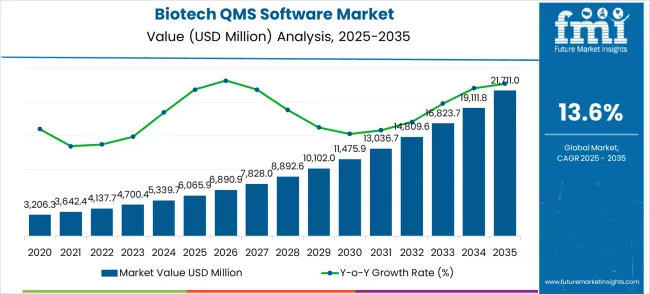
In the forecast period, the market is likely to be influenced by the rapid expansion of the biotech sector, particularly in areas like biologics, gene therapies, and personalized medicine. The increasing complexity of biotech operations and stringent regulations will fuel the demand for more efficient and automated QMS solutions. Furthermore, the rise in global collaborations and partnerships within the biotech ecosystem is expected to accelerate the need for robust quality systems that ensure consistency across diverse geographies and production environments. Biotech companies are increasingly focused on optimizing their operations while meeting regulatory standards, thereby further driving the adoption of QMS software. With the expanding applications of biotech in healthcare and pharmaceuticals, the market is poised to experience a strong upward trajectory in the coming decade.
| Metric | Value |
|---|---|
| Market Value (2025) | USD 6,065.9 million |
| Market Forecast Value (2035) | USD 21,711.0 million |
| Market Forecast CAGR | 13.6% |
The biotech QMS software market has established a key presence within the quality management software market, contributing around 6% of the total share, as the need for streamlined quality systems becomes central to biotech operations. Within the biotech software market, it accounts for approximately 10%, driven by the increasing reliance on software solutions for regulatory compliance and efficient operations. In the healthcare software market, the market share is about 7%, highlighting the application of QMS tools in biotech-related healthcare settings. The regulatory compliance software market contributes approximately 8%, as QMS software is integral to ensuring adherence to industry standards. In the pharmaceutical software market, the biotech QMS software market holds roughly 5%, given its use in ensuring the quality and safety of biopharmaceutical products.
Market expansion is being supported by the rapid increase in biotechnology regulatory requirements worldwide and the corresponding need for sophisticated quality management systems that provide comprehensive compliance tracking and automated regulatory reporting in modern biotech research and development environments. Modern biotechnology facilities rely on QMS software to deliver consistent regulatory compliance and comprehensive quality assurance including clinical trial management, drug development documentation, and regulatory submission preparation. Even minor compliance gaps can require comprehensive quality system adjustments to maintain optimal regulatory standing and operational approval.
The growing complexity of biotechnology quality requirements and increasing demand for integrated digital compliance solutions are driving demand for QMS software from certified technology providers with appropriate biotechnology expertise and regulatory knowledge. Biotechnology companies and pharmaceutical organizations are increasingly requiring documented compliance capabilities and system validation to maintain regulatory approval and operational effectiveness. Industry specifications and regulatory standards are establishing standardized quality management procedures that require specialized QMS technologies and trained quality professionals.
The Biotech QMS Software market is entering a new phase of explosive growth, driven by demand for regulatory compliance, digital transformation, and evolving biotechnology standards. By 2035, these pathways together can unlock USD 4.5-5.8 billion in incremental revenue opportunities beyond baseline growth.
Pathway A -- Cloud-Based Solution Leadership (SaaS Platforms) The cloud-based segment already holds the largest share due to scalability and accessibility advantages. Expanding AI integration, regulatory intelligence, and global compliance frameworks can consolidate leadership. Opportunity pool: USD 1.2-1.6 billion.
Pathway B -- Life Sciences Excellence (Pharmaceutical & Biotech) Life sciences represent the largest application segment. Growing precision medicine development, especially in emerging therapeutic areas, will drive higher adoption of specialized QMS solutions. Opportunity pool: USD 1.0-1.3 billion.
Pathway C -- AI-Powered Quality Intelligence (Predictive Analytics) Artificial intelligence enables predictive quality management and risk detection. AI-enhanced QMS solutions for automated compliance monitoring and predictive quality analytics offer premium positioning. Opportunity pool: USD 800 million-1.1 billion.
Pathway D -- Clinical Research Optimization (CRO & Clinical Trials) Clinical research requires specialized quality management for regulatory compliance. Enhanced QMS solutions for clinical trial management and regulatory submission support create significant growth opportunities. Opportunity pool: USD 600-800 million.
Pathway E -- Regulatory Intelligence Integration (Automated Compliance) Regulatory landscapes change rapidly requiring intelligent compliance systems. QMS solutions with automated regulatory updates and compliance mapping offer substantial value. Opportunity pool: USD 500-700 million.
Pathway F -- Small and Mid-Size Enterprise Penetration SME biotechnology companies require cost-effective QMS solutions. Affordable, easy-to-deploy QMS software for smaller biotech firms creates volume growth opportunities. Opportunity pool: USD 350-500 million.
Pathway G -- Emerging Market Expansion (Global Biotech Growth) Developing countries are expanding biotechnology capabilities. Localized QMS solutions for emerging biotech markets create new regional opportunities. Opportunity pool: USD 250-350 million.
Pathway H -- Integration and Ecosystem Solutions Biotechnology companies require integrated quality ecosystems. QMS platforms that integrate with laboratory systems, manufacturing, and regulatory databases offer comprehensive positioning. Opportunity pool: USD 200-300 million.
The market is segmented by deployment model, application, and region. By deployment model, the market is divided into on-premise and cloud-based. Based on application, the market is categorized into clinical research and life sciences. Regionally, the market is divided into North America, Europe, East Asia, South Asia & Pacific, Latin America, and Middle East & Africa.
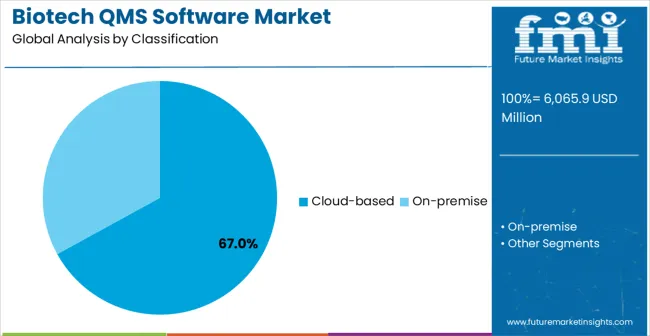
In 2025, the cloud-based biotech QMS software segment is projected to capture around 67% of the total market share, making it the leading deployment category. This dominance is largely driven by the widespread adoption of scalable cloud solutions that provide enhanced accessibility and cost-effective deployment options, catering to a wide variety of biotechnology organizations with distributed teams and global operations. Cloud-based QMS technology is particularly favored for its ability to deliver consistent system performance across multiple locations while ensuring real-time collaboration and centralized data management. Biotechnology companies, pharmaceutical manufacturers, contract research organizations, and clinical development firms increasingly prefer cloud deployments, as they meet stringent regulatory requirements without imposing excessive IT infrastructure investments or complex maintenance procedures.
The availability of well-established cloud security frameworks, along with comprehensive validation documentation and technical support from leading QMS software providers, further reinforces the segment's market position. Additionally, this deployment category benefits from consistent demand across regions, as it is considered a practical high-performance solution for organizations requiring flexible access and scalable quality management capabilities. The combination of operational flexibility, cost efficiency, and regulatory compliance makes cloud-based biotech QMS software a preferred choice, ensuring their continued popularity in the digital quality management market.
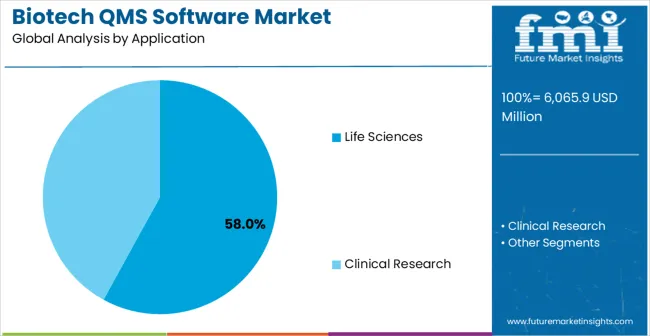
The life sciences segment is expected to represent 58% of biotech QMS software demand in 2025, highlighting its position as the most significant application sector. This dominance stems from the unique operational needs of life sciences organizations, where comprehensive quality management and regulatory compliance are critical to product development and market authorization success. Life sciences facilities often feature complex research and development workflows that extend throughout lengthy product development cycles, demanding robust and scalable quality management systems. Biotech QMS software is particularly well-suited to these environments due to its ability to manage diverse quality processes including research documentation, manufacturing quality control, and regulatory submission preparation, even during complex multi-site development programs. As life sciences companies globally advance toward precision medicine and advanced therapeutic development, the demand for comprehensive QMS capabilities continues to rise.
The segment also benefits from increased investment in biotechnology innovation and drug development programs, where organizations are increasingly prioritizing quality system integration and regulatory efficiency as essential competitive advantages. With life sciences companies investing in digital transformation initiatives and regulatory excellence programs, QMS software provides an essential solution to maintain superior compliance performance. The growth of personalized medicine, gene therapy development, and advanced biomanufacturing applications, coupled with increased focus on regulatory harmonization, ensures that life sciences will remain the largest and most stable demand driver for biotech QMS software in the forecast period.
The Biotech QMS Software market is advancing rapidly due to increasing regulatory complexity and growing recognition of digital quality management advantages over paper-based quality systems in biotechnology operations. However, the market faces challenges including high initial software implementation costs compared to traditional quality systems, complex system validation requirements for regulatory compliance, and varying data privacy regulations across different geographic regions. Performance optimization efforts and regulatory technology advancement programs continue to influence software development and market adoption patterns.
The growing development of AI-powered quality analytics is enabling predictive quality insights with enhanced risk detection and automated compliance monitoring capabilities. Advanced artificial intelligence technologies and machine learning algorithms provide superior quality intelligence while maintaining regulatory compliance requirements. These technologies are particularly valuable for biotechnology companies and pharmaceutical organizations who require intelligent quality systems that can support complex regulatory environments with predictive compliance capabilities.
Modern biotech QMS software providers are incorporating advanced real-time monitoring capabilities and IoT integration systems that enhance quality visibility and operational responsiveness. Integration of continuous monitoring technologies and automated alert systems enables superior quality control and comprehensive compliance tracking capabilities. Advanced monitoring features support operation in diverse biotechnology environments while meeting various regulatory requirements and quality specifications.
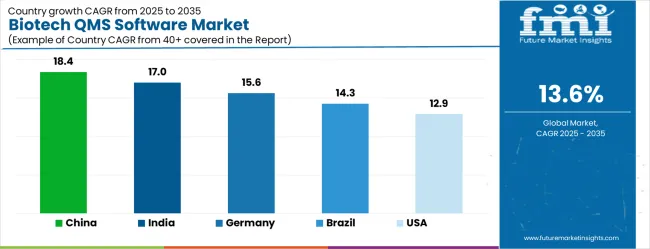
| Country | CAGR (2025-2035) |
|---|---|
| China | 18.4% |
| India | 17.0% |
| Germany | 15.6% |
| Brazil | 14.3% |
| United States | 12.9% |
| United Kingdom | 11.6% |
| Japan | 10.2% |
The biotech QMS software market is experiencing explosive growth, with China leading at an 18.4% CAGR through 2035, driven by rapid biotechnology industry expansion and increasing adoption of digital quality management systems across pharmaceutical development, clinical research, and biomanufacturing sectors. India follows at 17.0%, supported by rising biotechnology services industry growth and growing demand for regulatory compliance solutions for global pharmaceutical markets. Germany grows robustly at 15.6%, integrating QMS software technology into its established pharmaceutical manufacturing and biotechnology research infrastructure. Brazil records 14.3%, emphasizing biotechnology industry modernization and regulatory compliance enhancement initiatives. The United States shows substantial growth at 12.9%, focusing on advanced biotechnology development and pharmaceutical innovation. The United Kingdom demonstrates strong progress at 11.6%, maintaining established biotechnology research applications and pharmaceutical technology leadership. Japan records 10.2% growth, concentrating on precision biotechnology manufacturing and ultra-high quality pharmaceutical production standards.
The report covers an in-depth analysis of 40+ countries, the top-performing countries are highlighted below.
The biotech QMS software market in China is projected to exhibit the highest growth rate with a CAGR of 18.4% through 2035, driven by massive biotechnology industry expansion programs and increasing demand for digital quality management systems across pharmaceutical development, clinical research, and biomanufacturing operations. The country's aggressive biotechnology modernization and growing domestic drug development capabilities are creating significant demand for advanced QMS software solutions. Major biotechnology companies and pharmaceutical manufacturers are establishing comprehensive digital quality management platforms to support the increasing requirements of regulatory agencies and international pharmaceutical markets across major biotechnology development zones.
National biotechnology development initiatives are supporting establishment of world-class pharmaceutical manufacturing facilities and biotechnology research centers, driving demand for advanced quality management software throughout major biotechnology industrial parks. Biotechnology industry modernization programs are facilitating adoption of digital quality technologies that enhance regulatory compliance capabilities and international competitiveness across pharmaceutical supply chains.
The biotech QMS software market in India is expanding at a CAGR of 17.0%, supported by increasing biotechnology services industry development and growing demand for regulatory compliance solutions for global pharmaceutical and clinical research markets. The country's expanding contract research and manufacturing sector and rising international quality standards are driving demand for advanced QMS software solutions. Biotechnology service providers and pharmaceutical companies are gradually implementing professional-grade quality management systems to maintain international compliance and competitive positioning.
Biotechnology services industry growth and global market integration are creating opportunities for software suppliers that can support diverse regulatory requirements and international quality specifications. Professional training and development programs are building technical expertise among biotechnology quality professionals, enabling effective utilization of QMS software that meets international standards and regulatory requirements.
The biotech QMS software market in Germany is projected to grow at a CAGR of 15.6%, supported by the country's emphasis on pharmaceutical manufacturing quality standards and advanced biotechnology research adoption. German pharmaceutical companies and biotechnology manufacturers are implementing cutting-edge QMS software systems that meet stringent regulatory requirements and international quality specifications. The market is characterized by focus on system validation, regulatory compliance, and integration with comprehensive pharmaceutical engineering standards.
Pharmaceutical manufacturing industry investments are prioritizing advanced quality management technology that demonstrates superior regulatory compliance and operational efficiency while meeting German quality and international pharmaceutical standards. Professional certification programs are ensuring comprehensive technical expertise among pharmaceutical quality engineers and biotechnology specialists, enabling specialized QMS capabilities that support diverse pharmaceutical applications and regulatory requirements.
The biotech QMS software market in Brazil is growing at a CAGR of 14.3%, driven by increasing biotechnology facility modernization and growing recognition of digital quality management advantages for pharmaceutical development and regulatory compliance. The country's expanding biotechnology sector is gradually integrating advanced QMS software to enhance regulatory compliance and international market access. Biotechnology companies and pharmaceutical organizations are investing in quality management technology to address evolving regulatory expectations and export competitiveness.
Biotechnology modernization is facilitating adoption of advanced digital quality technologies that support comprehensive pharmaceutical and biotechnology capabilities across research and manufacturing regions. Professional development programs are enhancing technical capabilities among biotechnology quality professionals, enabling effective QMS software utilization that meets evolving regulatory standards and international requirements.
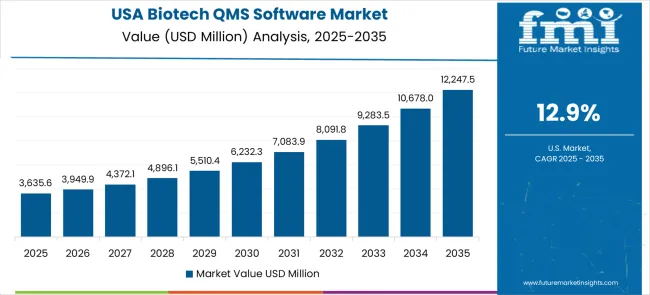
The biotech QMS software market in the USA is expanding at a CAGR of 12.9%, driven by established biotechnology industry leadership and growing emphasis on pharmaceutical innovation and regulatory excellence programs. Large pharmaceutical companies and biotechnology firms are implementing comprehensive QMS software capabilities to serve diverse drug development and regulatory compliance requirements. The market benefits from established biotechnology networks and professional training programs that support various pharmaceutical and clinical research applications.
Biotechnology industry leadership is enabling standardized quality management technology utilization across multiple development types, providing consistent regulatory compliance and comprehensive quality coverage throughout regional biotechnology markets. Professional development and certification programs are building specialized technical expertise among biotechnology and pharmaceutical quality professionals, enabling effective QMS software utilization that supports evolving biotechnology development requirements.
The biotech QMS software market in the UK is projected to grow at a CAGR of 11.6%, supported by established biotechnology research sectors and growing emphasis on pharmaceutical technology innovation capabilities. British biotechnology companies and pharmaceutical providers are implementing QMS software that meets industry regulatory standards and international quality requirements. The market benefits from established biotechnology infrastructure and comprehensive training programs for biotechnology professionals.
Biotechnology research investments are prioritizing advanced quality management systems that support diverse pharmaceutical applications while maintaining established regulatory and technical standards. Professional development programs are building biotechnology expertise among technology personnel, enabling specialized QMS software operation capabilities that meet evolving institutional requirements and biotechnology standards.
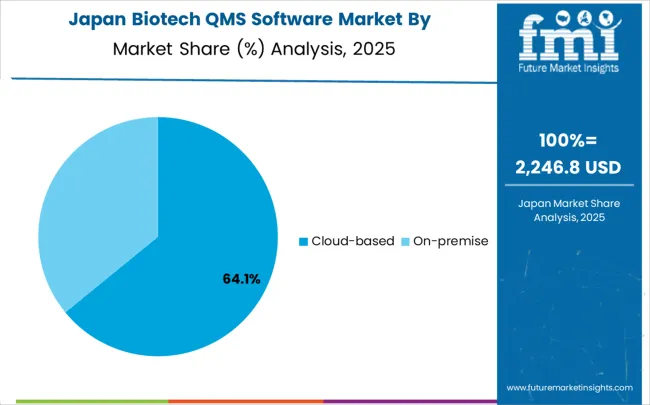
The biotech QMS software market in Japan is growing at a CAGR of 10.2%, driven by the country's focus on precision biotechnology manufacturing innovation and ultra-high quality pharmaceutical production applications. Japanese biotechnology companies and pharmaceutical manufacturers are implementing advanced QMS software systems that demonstrate superior quality reliability and operational excellence. The market is characterized by emphasis on technological perfection, regulatory assurance, and integration with established pharmaceutical manufacturing workflows.
Biotechnology industry investments are prioritizing innovative quality management solutions that combine advanced QMS technology with precision engineering while maintaining Japanese pharmaceutical quality and reliability standards. Professional development programs are ensuring comprehensive technical expertise among biotechnology quality engineers and pharmaceutical specialists, enabling specialized precision quality capabilities that support diverse biotechnology applications and regulatory requirements.
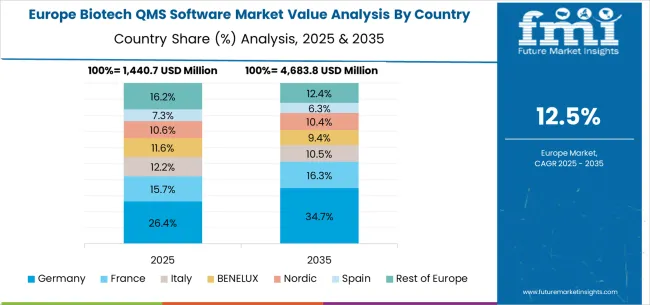
The biotech QMS software market in Europe is forecast to expand from USD 1,584.3 million in 2025 to USD 5,669.9 million by 2035, registering a CAGR of 13.6%. Germany will remain the largest market, holding 33.5% share in 2025, easing to 33.0% by 2035, supported by strong pharmaceutical manufacturing infrastructure and advanced biotechnology research capabilities. The United Kingdom follows, rising from 29.0% in 2025 to 29.5% by 2035, driven by biotechnology research innovation and pharmaceutical technology advancement. France is expected to maintain stability around 22.0%, reflecting steady biotechnology investment patterns. Italy maintains stability at around 9.5%, supported by pharmaceutical manufacturing and biotechnology research growth, while Spain grows from 4.5% to 5.0% with expanding biotechnology infrastructure and pharmaceutical modernization. BENELUX markets ease from 1.3% to 1.2%, while the remainder of Europe hovers near 0.2%-0.3%, balancing emerging Eastern European biotechnology development against mature Nordic pharmaceutical technology markets.
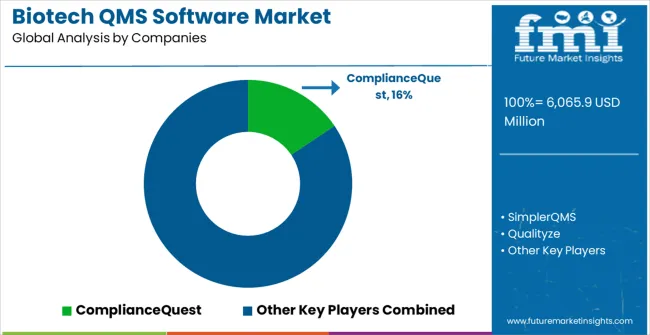
The Biotech QMS Software market is defined by competition among specialized quality management software providers, enterprise software companies, and biotechnology technology solution developers. Companies are investing in advanced regulatory intelligence development, AI-powered quality analytics, cloud platform optimization, and comprehensive biotechnology application capabilities to deliver reliable, compliant, and cost-effective quality management solutions. Strategic partnerships, technological innovation, and market expansion are central to strengthening product portfolios and market presence.
ComplianceQuest offers comprehensive cloud-based quality management solutions with established biotechnology expertise and regulatory compliance capabilities. SimplerQMS provides specialized quality management software with focus on life sciences applications and regulatory workflow automation. Qualityze delivers advanced quality management platforms with emphasis on biotechnology process integration and compliance tracking. MRPeasy specializes in manufacturing resource planning with integrated quality management functionalities.
Qualio offers modern quality management software with focus on life sciences regulatory compliance and collaborative workflows. TecWork Global Business Solutions provides comprehensive quality management systems with emphasis on pharmaceutical manufacturing applications. Siemens BIOVIA delivers advanced scientific informatics solutions with quality management integration capabilities. Merk, MasterControl Solutions, AssurX, DevonWay, BIOMÉRIEUX, QBench, Intellect, EtQ, and SAP offer specialized biotechnology expertise, software reliability, and comprehensive quality management development across global and regional biotechnology market segments.
| Item | Value |
|---|---|
| Quantitative Units | USD 6,065.9 million |
| Deployment Model | On-premise, Cloud-based |
| Application | Clinical Research, Life Sciences |
| Regions Covered | North America, Europe, East Asia, South Asia & Pacific, Latin America, Middle East & Africa |
| Country Covered | China, India, Germany, Brazil, United States, United Kingdom, Japan, and 40+ countries |
| Key Companies Profiled | ComplianceQuest, SimplerQMS, Qualityze, MRPeasy, Qualio, TecWork Global Business Solutions, Siemens BIOVIA, Merk, MasterControl Solutions, AssurX, DevonWay, BIOMÉRIEUX, QBench, Intellect, EtQ, SAP |
| Additional Attributes | Dollar sales by deployment model and application segment, regional demand trends across major markets, competitive landscape with established quality management software providers and emerging biotechnology technology specialists, customer preferences for different deployment approaches and integration options, compatibility with biotechnology research systems and regulatory compliance protocols, innovations in artificial intelligence integration and regulatory intelligence technologies, and adoption of real-time monitoring features with enhanced compliance capabilities for improved biotechnology quality workflows. |
The global emulsifiable metalworking fluid market is estimated to be valued at USD 5,112.6 million in 2025.
The market size for the emulsifiable metalworking fluid market is projected to reach USD 7,495.4 million by 2035.
The emulsifiable metalworking fluid market is expected to grow at a 3.9% CAGR between 2025 and 2035.
The key product types in emulsifiable metalworking fluid market are metal cutting fluids, metal forming fluids, metal protecting fluids and metal treating fluids.
In terms of application, machinery manufacturing segment to command 43.0% share in the emulsifiable metalworking fluid market in 2025.






Our Research Products

The "Full Research Suite" delivers actionable market intel, deep dives on markets or technologies, so clients act faster, cut risk, and unlock growth.

The Leaderboard benchmarks and ranks top vendors, classifying them as Established Leaders, Leading Challengers, or Disruptors & Challengers.

Locates where complements amplify value and substitutes erode it, forecasting net impact by horizon

We deliver granular, decision-grade intel: market sizing, 5-year forecasts, pricing, adoption, usage, revenue, and operational KPIs—plus competitor tracking, regulation, and value chains—across 60 countries broadly.

Spot the shifts before they hit your P&L. We track inflection points, adoption curves, pricing moves, and ecosystem plays to show where demand is heading, why it is changing, and what to do next across high-growth markets and disruptive tech

Real-time reads of user behavior. We track shifting priorities, perceptions of today’s and next-gen services, and provider experience, then pace how fast tech moves from trial to adoption, blending buyer, consumer, and channel inputs with social signals (#WhySwitch, #UX).

Partner with our analyst team to build a custom report designed around your business priorities. From analysing market trends to assessing competitors or crafting bespoke datasets, we tailor insights to your needs.
Supplier Intelligence
Discovery & Profiling
Capacity & Footprint
Performance & Risk
Compliance & Governance
Commercial Readiness
Who Supplies Whom
Scorecards & Shortlists
Playbooks & Docs
Category Intelligence
Definition & Scope
Demand & Use Cases
Cost Drivers
Market Structure
Supply Chain Map
Trade & Policy
Operating Norms
Deliverables
Buyer Intelligence
Account Basics
Spend & Scope
Procurement Model
Vendor Requirements
Terms & Policies
Entry Strategy
Pain Points & Triggers
Outputs
Pricing Analysis
Benchmarks
Trends
Should-Cost
Indexation
Landed Cost
Commercial Terms
Deliverables
Brand Analysis
Positioning & Value Prop
Share & Presence
Customer Evidence
Go-to-Market
Digital & Reputation
Compliance & Trust
KPIs & Gaps
Outputs
Full Research Suite comprises of:
Market outlook & trends analysis
Interviews & case studies
Strategic recommendations
Vendor profiles & capabilities analysis
5-year forecasts
8 regions and 60+ country-level data splits
Market segment data splits
12 months of continuous data updates
DELIVERED AS:
PDF EXCEL ONLINE
Food Biotechnology Market Size and Share Forecast Outlook 2025 to 2035
Marine Biotech Ingredients Market Analysis - Size and Share Forecast Outlook 2025 to 2035
Software-Defined Wide Area Network Market Size and Share Forecast Outlook 2025 to 2035
Software Defined Vehicle Market Size and Share Forecast Outlook 2025 to 2035
Software Defined Networking (SDN) And Network Function Virtualization (NFV) Market Size and Share Forecast Outlook 2025 to 2035
Software Defined Perimeter (SDP) Market Size and Share Forecast Outlook 2025 to 2035
Software-Defined Wide Area Network SD-WAN Market Size and Share Forecast Outlook 2025 to 2035
Software Defined Radio (SDR) Market Size and Share Forecast Outlook 2025 to 2035
Software License Management (SLM) Market Size and Share Forecast Outlook 2025 to 2035
Software-Defined Networking SDN Market Size and Share Forecast Outlook 2025 to 2035
Software-Defined Anything (SDx) Market Size and Share Forecast Outlook 2025 to 2035
Software-Defined Data Center Market Size and Share Forecast Outlook 2025 to 2035
Software Containers Market Size and Share Forecast Outlook 2025 to 2035
Software Defined Application And Infrastructure Market Size and Share Forecast Outlook 2025 to 2035
Software Defined Networking Market Size and Share Forecast Outlook 2025 to 2035
Software-Defined Camera (SDC) Market Size and Share Forecast Outlook 2025 to 2035
Examining Market Share Trends in the Software Distribution Industry
Software Distribution Market Analysis by Deployment Type, by Organization Size and by Industry Vertical Through 2035
Software Defined Video Networking Market
UK Software Distribution Market Analysis – Size & Industry Trends 2025-2035

Thank you!
You will receive an email from our Business Development Manager. Please be sure to check your SPAM/JUNK folder too.
Chat With
MaRIA